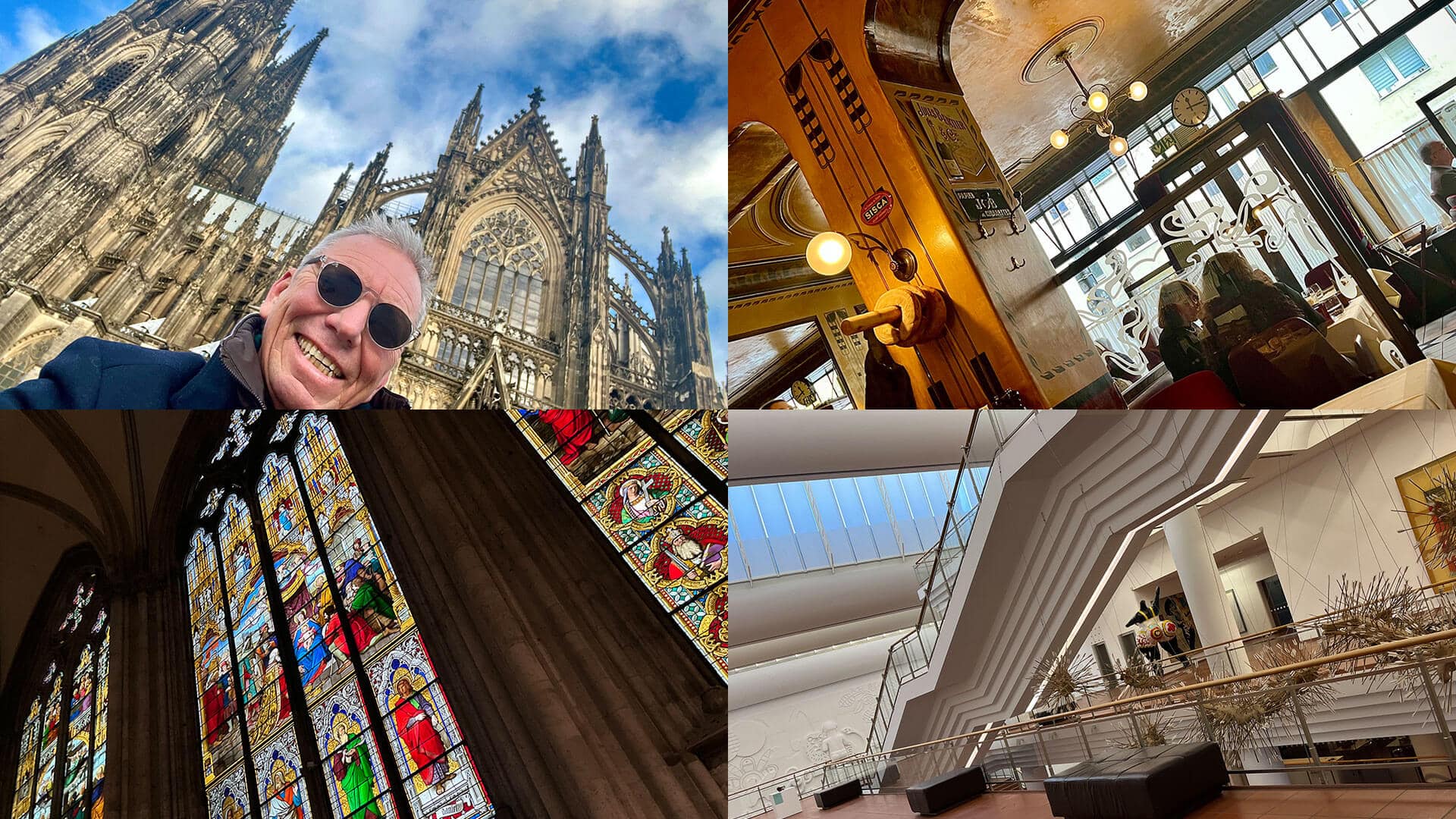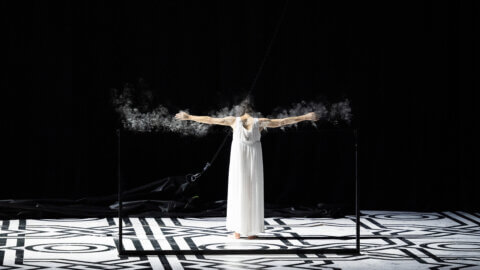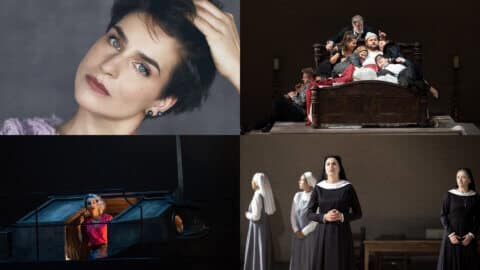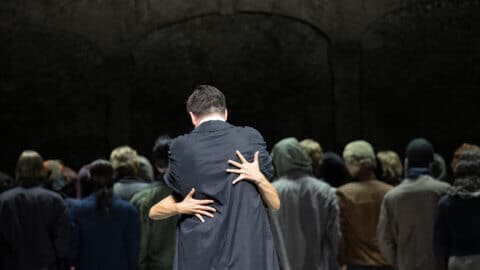LA BOHÊME • COLOGNE OPERA
★★★★☆☆

Photo: Hans Jörg Michel
REVIEW LA BOHEME: ULTRA CLASSIC CROWDPLEASER IN COLOGNE
A sympathetic singing team without the big profiles momentarily convinces in Cologne’s production of la Bohême in the ultra-classic version of Puccini’s Parisian tearjerker by the recently deceased German director, theatre director and cultural personality Michael Hampe.
A difficult hall without an orchestra pit is the temporary venue for the Cologne Opera whose normal home – a beautiful retro-looking 1957 opera house in the city center near the cathedral, is the subject of a major renovation and building scandal with massive budget overruns and delays.
The Staatenhaus on the opposite side of the Rhine is funked up quite well in style of modern art museum on and seems particularly suited to modern, scenic touches.
For example, as in the highly acclaimed Les Troyens by Berlioz in Johannes Erath’s 2022 Cologne hit production, with the stage arranged as a circular runway with the orchestra placed in the middle.
The performance was hailed as a triumph for both director and conductor François-Xavier Roth.
A performance I sadly missed, but which drew my attention to the Cologne Opera and their esteemed performances of a modern additions. Keep an eye on the opera’s website.
La Boheme, as you know, is performed in four pictures. First picture in the apartment of the Bohemians, where Mimi is introduced and Rodolfo soon notices ‘how cold that little hand is’.
Second picture in the marketplace around the Momus tribal café, where unruly Musette is making fun of his wealthy admirers. Like the others, she is modelled on a real person who actually managed to save up to settle in Algiers with her sister, but drowned on the voyage when her ship Atlas went down before they reached North Africa.
After the interval, we get the third picture in the biting cold at the city gate, including an unusually beautiful snowstorm – and the fourth picture back in the apartment, where life finally seeps out of Mimi, in one of the most iconic scenes in opera history.
Best of all was the third picture, which includes Mimi’s poignant farewell aria as she breaks up with Rodolfo.
Here the young, Italian, perfectly casted Angela Nisi lived up to expectations for the treasured soprano part, with a strong, lyrical performance both vocally and dramatically, whereas Filipino/American tenor Arthur Espiritu as Rodolfo did not hit top form this evening.
The interplay with the bohemian friends seemed wildly postulated and mostly amounted to overplayed homie gestures and folk comedy fun. It all smacked more of duty than desire, that’s for sure.
The orchestra was well played especially in the quiet, delicious sequences, but it was as if the (warehouse) hall itself was resisting. The many heavy curtains on the concrete walls put such a damper on the acoustics that the sound experience came to lack edge, sparkle and nerve.
With no revolving stage, scenery hoist or lifts, scene changes were left to an army of stagehands, who actually managed to establish new, believable locations astonishingly quickly and efficiently before the eyes of a sold-out hall. Quite a little theatre in itself, though perhaps not exactly what one had come for.
The market scene in the 2nd picture was impressive set design with a huge cast, densely packed in lively mass choreography and festive Parisian cliché execution that seemed so family friendly that the show looked like a Christmas/New Year tradition on a par with The Nutcracker.
All in all, a Bohême that has been both heard and seen better, but which gave its audience an authentic and loyally staged quality experience of one of the world’s most performed operas.
The ominous horns that reveal Mimi’s death in the finale are still a thrillingly good Puccini touch that went straight to the heart and sent the audience home with tears in their eyes.

MY COLOGNE QUICK TIPS
Cologne is perhaps a little overlooked but obvious weekend destination, which I visited myself 20 years ago and had forgotten most of.
After World War I, the victorious coalition occupied the whole of the Rhineland and the British, who banned Cologne’s beloved carnival, stayed in the city until 1926. Today, the carnival is a beloved institution in the city, starting at exactly 11 minutes past 11 on 11.11 and lasting until over Easter!
At Le Moisonnier I had the best lunch I remember having in Germany. The restaurant has two Michelin stars, and is worth a trip in itself. It takes about an hour to get there by plane and I’ve seen Ryanair prices as low as 99 kroner for a ticket from Copenhagen. Consider.
The cathedral is impressive in all weathers, and nearby both Peters Brauhaus and the Frïh am Dom brewery tempt with sparkling fresh Kølch (draught beer in small glasses) and hearty German farmhouse fare.
For something more hip, Poisson is a designer-style seafood restaurant with an open kitchen and a table at the kitchen counter.
Cultural experiences are aplenty at Museum Ludvig (modern art in cool museum architecture) or the impressive Philharmonie, which offers frequent classical concerts by top names.
On a sudden whim, I experienced Robert Schumann’s oratorio Paradies in full on a Sunday morning with an almost full house. The conductor was the aforementioned François-Xavier Roth.
A little more in the service of broad taste is the virtual reality experience Cologne 1926 – a fun little tourist thing that shows how the city and life shaped Cologne in the 1920s.
Sitting in a tram with VR glasses on, you’re pretty amazed to see what this place looked like before the Allies laid waste to the city with 162 bombing raids in 1944, 3 of which involved over 1000 bombers at a time.
The Cologne Dom was the bombers’ preferred target, but miraculously avoided the destruction that befell the rest of the city.




